After a spring of cooler temperatures and unseasonable rain, one of Australia’s leading snake experts is warning golfers to remain vigilant on – and particularly off – the fairways this summer.
[Feature image: Getty images – Ikhsan Yohanda]
“People say bunker shots are daunting… have they tried playing them in Australia?” asked Aussie comedian Andy Lee during a recent trip to Barnbougle Dunes in Tasmania.
Lee, a golf tragic, had whipped out his phone to film his playing partner’s ball in a bunker at the Lost Farm course when the challenge at hand quickly became apparent. Slithering in the sand just metres from playing partner Michael Horgan’s ball was a large tiger snake.
“Horgs, you’ve got a bit of a tough bunker shot coming up,” Andy warned his mate, who was still to arrive at his ball.
“Obviously the light’s not great, but this tiger snake over here is all the worry… it’s huge!”
Such scenes are all too common for golfers in the Land Down Under but, luckily, the majority remain nothing more than a funny story to tell, or in today’s age of Instagram, a viral video like Lee’s to freak out the rest of the world.
As Aussies tend to do, we rarely let such hazards worry us.
“I was told about a snake on the fifth fairway while playing at Shepparton,” recalls Jennifer Petri. “My response was, ‘I’ll be safe while it’s on a fairway.’”
Sometimes, though, there are no warnings.
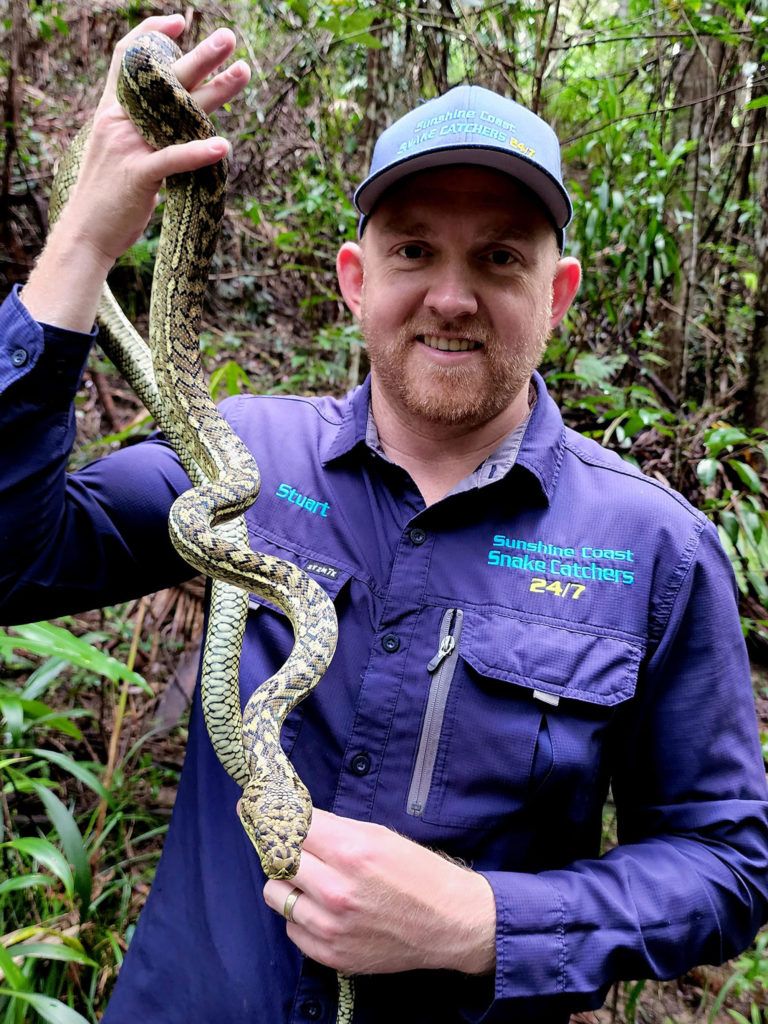
Take the West Australian golfer who was searching for his ball in the rough recently when, out of nowhere, he was bitten by a native Dugite snake. Fortunately, there was minimal venom injected, and just as well because the man kept playing and made two birdies in his closing four holes before finally checking himself into hospital. Bloody Aussies.
Others aren’t so lucky. Norman Santoso was enjoying one of his better rounds on a warm December day at Centenary Park Golf Course in Melbourne’s south-east before it was rudely interrupted by a scaly encounter.
“I was playing well… one-over after six holes and then – BOOM! – my round was over,” Santoso says. “I was bitten by a small brown snake and ended up in ICU for the night.”
Suffice to say, whether it’s a heathy dose of humour, common sense or anti-venom, golfers and snakes have managed to co-exist for generations. It’s something one of the country’s most recognisable snake experts wants to ensure continues well past this summer.
▶ ▶ ▶
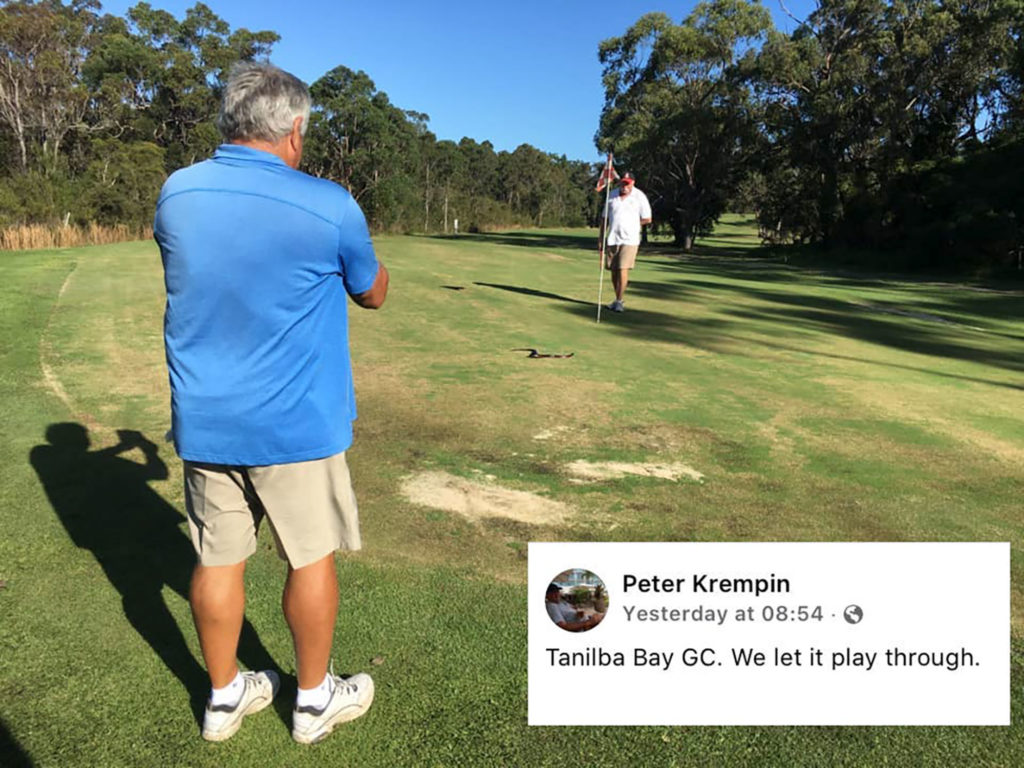
Stuart McKenzie didn’t set out to be a TV star. What started as a hobby while working at Australia Zoo quickly morphed into a 24/7 job that’s seen him go from hunting in people’s backyards and golf courses as the chief of Sunshine Coast Snake Catchers, to appearing in their living rooms every week on the big box.
Eagle-eyed readers may recognise McKenzie as the reptile-retrieving hero on “Aussie Snake Wranglers”, which has quickly become one of National Geographic’s most successful locally produced shows via its home on Foxtel. With a thirst for adrenalin and a love for serpents, McKenzie realised there was a gap in the market for real-life reptile relocation and was determined to make a full-time fist of it.
“It took me three or four years to get the business to the stage where it was big enough that I could leave the zookeeper work and be a snake catcher full-time,” he says. “Since then, the business has exploded, and we now have around five full-time staff plus another 15 or 20 sub-contractors that help us on a regular basis. We have a huge following on social media, where we post a lot of cool content of us catching and relocating snakes.”
It was that active social media following that became the inspiration behind the television series, which just finished filming its third season and captures McKenzie and his team on deadly callouts to remove all forms of slithering danger from homes and businesses.
Not surprisingly, a lot of McKenzie’s work is outdoors, with countless callouts to local golf courses each month. He says that while unseasonable wet and cool weather has made for a slow start to the traditional Aussie snake season, golfers need to remain vigilant on the course.
“Usually, we see a huge increase in snake sightings at the start of September, however due to the cooler temperatures and wet weather, September and October were down on last year,” McKenzie says. “I still expect there to be plenty of snakes on the move over the next six months or so, especially during January, February and March.”
McKenzie said the country’s never-ending urban development and construction demands will render snake sightings inevitable, but we needn’t be alarmed when they happen.
“Snakes don’t pose a risk to humans unless the snake feels threatened by the human, so if anyone sees a snake, the best thing to do is keep a safe distance and give it the respect it deserves,” he says.
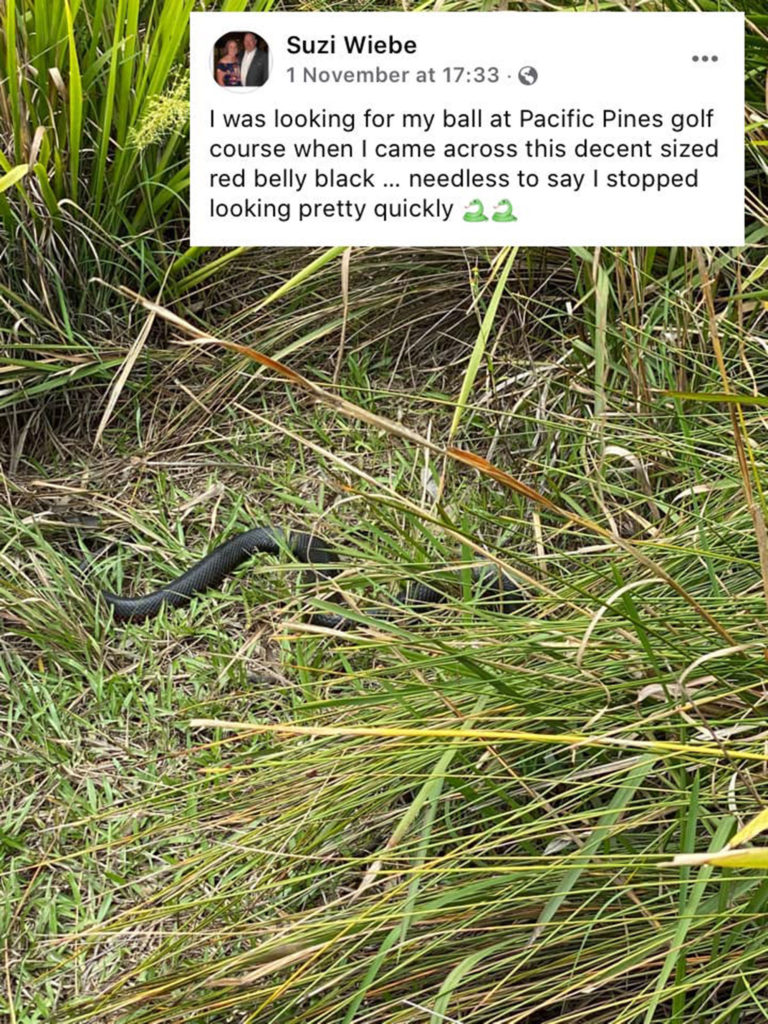
Be prepared and tread carefully
In February last year, ABC News reported how a teenage golfer survived a brown snake bite thanks to some quick thinking and immediate access to a snake-bite kit. Sixteen-year-old Isaiah Wilksch was punctured three times by the 1.5-metre brown at Cummins on South Australia’s Eyre Peninsula while enjoying a round with his mate.
“I thought I’d stepped on a stick with my other foot and the end of the stick just poked into my leg,” Wilksch said. “But when I looked down, I saw a brown snake slither off and I knew I’d been bitten. The snake got me three times in one very quick motion.”
Women’s and Children’s Hospital head of toxicology Julian White told ABC News brown snakes were responsible for the majority of snakebites and deaths by snakebite in Australia, with an average of two to three fatalities each year. He also revealed the majority of the deaths were from cardiac arrest before the patient reached hospital, and that the actions of Wilksch and his friend to swiftly administer a compression bandage and ensure he remained immobilised helped save his life.
Which poses a very serious and critically important question for every golfer in Australia: while your bag might be loaded with balls, markers and tees… items to save your game, does it contain a compression bandage to potentially save your life? If not, why?
“Snake-bite first aid must be done immediately,” warns McKenzie. “This involves the patient who has been bitten staying very still and as calm as possible. Apply a pressure bandage to the bitten limb in accordance with current snake-bite first aid procedures [see fact sheet above] and call an ambulance and wait for the ambulance to arrive.”
While knowing exactly what to do in times of an emergency, McKenzie again reinforced there was no need for golfers to be worried every time they arrive for their summer tee-time.
“Golfers aren’t necessarily at a high risk or in any danger of being bitten by snakes, but courses do provide the perfect environment for these animals and sightings are going to be inevitable,” he says.
“Golf courses usually have garden and bush areas with many water sources. These areas may be inhabited by snakes but it’s important to remember that they will always try their best to avoid humans at all costs. Golfers shouldn’t necessarily be concerned about snakes, but rather be aware that they may encounter one while playing golf.”
McKenzie says where golfers need to pay particular attention for their own safety is when shots veer off-course.
“Golfers need to be extra vigilant when going searching for their balls in long grass or bushland areas on the golf course,” he said. “Snakes like to sit on the edge of long grass or bushland to soak up the sun’s rays. They will generally feel you coming but some may be sheltering within the bush or long grass areas, so if you are going in deep to find your ball, just be careful. Snakes’ eyesight is generally very movement orientated so if it sees you, they will take off in the opposite direction most of the time.”
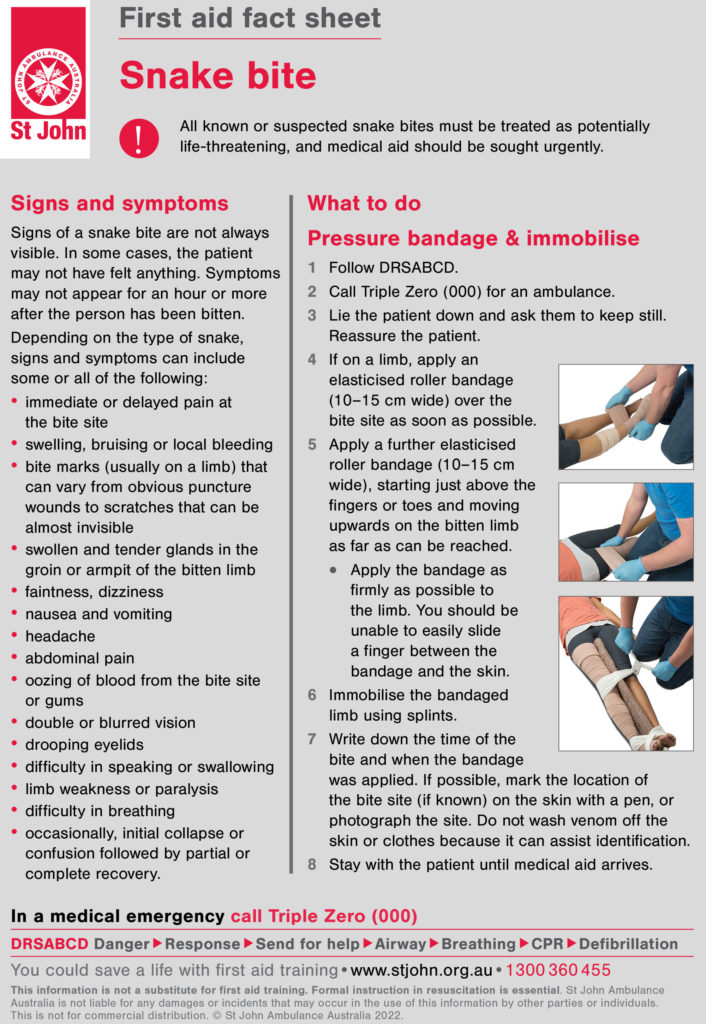
When mulligans are nearly required
As one can imagine, McKenzie’s day job is one of the more dangerous trades going around. Trying to locate then catch some of the deadliest creatures on the planet isn’t for the faint-hearted and doesn’t always go as smoothly as experts like him would like you to believe.
“The most nervous I have been on a job was when I arrived at a home in the Sunshine Coast hinterland where they had a six-foot Eastern Brown snake under their house,” he recalls. “There was only about four feet of crawl space under the house and there was only one entry/exit point. I had to use a long pole to poke and encourage the huge brown snake back around to the exit point before I could grab him outside. There wasn’t enough room to grab him safely under the house so I had to encourage this big venomous snake back out from under the house where I could catch it safely. The whole process took more than 30 minutes and by the end of it I was sweating bullets and absolutely knackered. Thankfully, I was able to relocate the snake safely.”
McKenzie and his team regularly attend a local golf course on the Sunshine Coast to relocate snakes from their mini-golf course facility. The course gets regular snake sightings on its main course too, but is usually happy to let them be, except for one occasion that nearly ended in embarrassment for the snake wrangler himself.
“I had to relocate a red-bellied black snake due to it crossing the main cart-path and nearly getting run over. I remember the snake being curled up next to a canal waterway on the course, so I had to be extra careful not to fall in as I went to grab the snake because it would have been comedy gold,” he laughed. “The snake went to take off and hide in the garden, but I was able to grab it by the tail and relocate it safely.”
Such stories should serve only to help golfers better understand the reclusive behaviours of snakes on golf courses, according to McKenzie.
“Snakes are very misunderstood creatures,” he says. “They are not aggressive, like many people say, but in fact extremely scared of humans. If humans give snakes the respect they deserve, then snakes will mean them no harm. I am asked about it all the time but the No.1 misconception about snakes is that people think they will chase you and that they are aggressive animals. Snakes will definitely not chase anyone and will always try to flee if the opportunity is there. However, if someone corners a snake or makes the snake feel threatened, then the snake may become defensive and try to strike or bite someone if they get too close.”
So, remember: if you see a snake this summer, admire it from afar and keep your round going. After all, your scorecard is likely to kill you long before any reptile ever will.
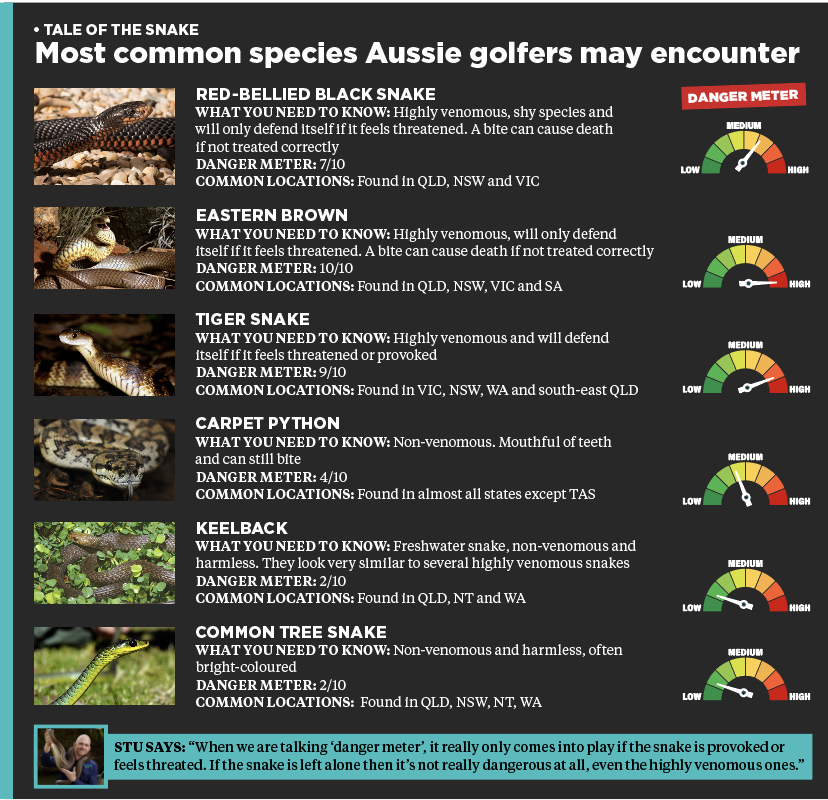
FROM THE ARCHIVES: When (rubber) snakes can help your game
If you tend to skull the ball out of greenside bunkers, you probably have a reputation with your playing partners. They watch you closely out of self-preservation. Check your spine angle. It just might save someone’s life.
Seriously, many golfers hit these shots because they set up with their spine leaning away from the target – like on a driver swing. In the sand, this leads to the club bottoming out too far behind the ball. The farther back the club contacts the sand, the greater your chances of hitting the ball on the upswing and blading it.
My snake drill can help you eliminate these shots. When you practise, scrape a line in the sand a few inches behind the ball and another line a few inches in front [below left]. I tell students to pretend these lines are snakes that you want to knock out of the sand. (People hate snakes almost as much as they hate bunkers.)
Play the ball opposite your front heel, and tilt your spine two inches towards the target. Swing back halfway, and on the downswing try to hit the first snake. If you keep the club moving, you’ll catch the second snake, too [below right]. And you’ll execute a perfect explosion. – Tom Stickney




